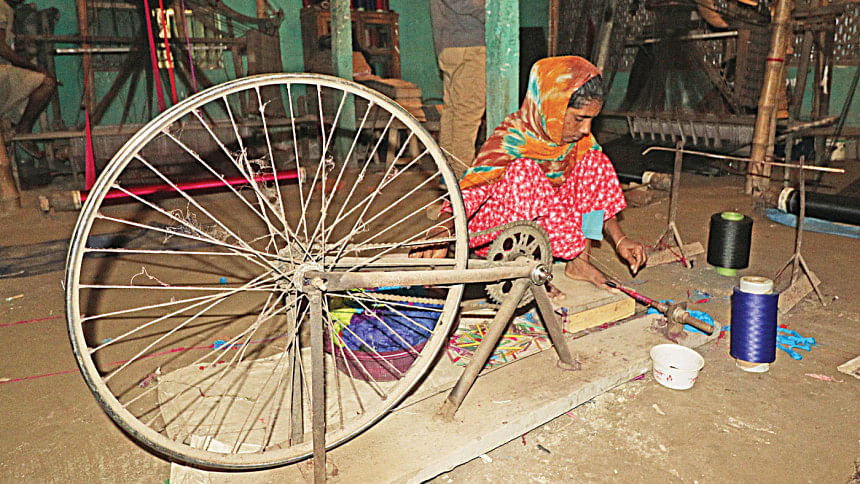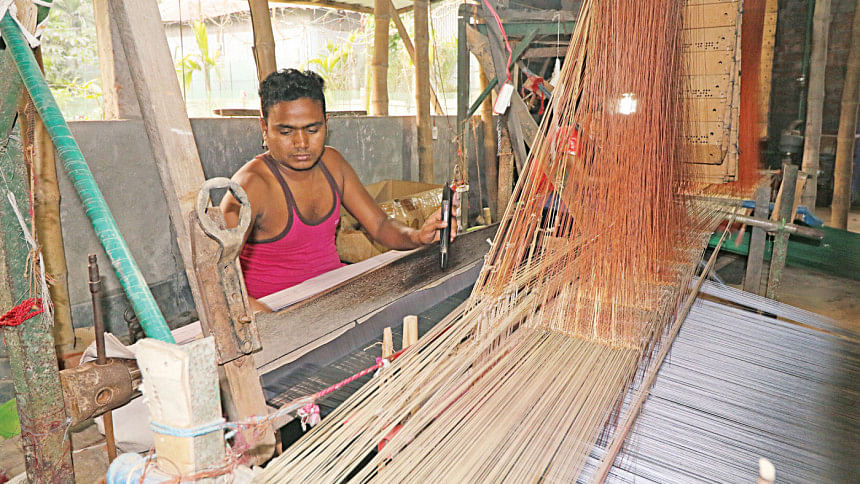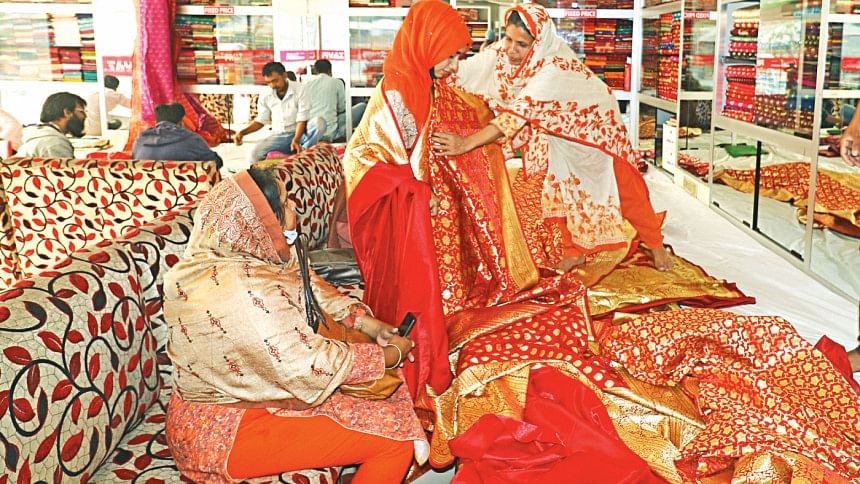Benarashi makers plagued by challenges

The Benarashi industry in Gangachara upazila of Rangpur is struggling to stay afloat because of increases in raw material prices and transportation cost as well as a decline of processing units and government support.
The Benarashi Palli, located in Gajaghanta union in the upazila, around 16 kilometres off Rangpur district headquarters, is home to about 300 weavers and an equal number of handlooms. They produce Benarashi products, such as sari, panjabi and salwar kameez.
The area became a new supplier of Benarashi products, following in the footsteps of major production regions such as Narayanganj, Pabna, and Mirpur of Dhaka, after Abdur Rahman of Taluk Habu village started weaving Benarashi saris on a limited scale in 1997 in an effort to create jobs in the near famine-hit area.
Seeing success, more and more villagers had shown interest in weaving Benarashi saris, setting up looms in their homes, as generating employment was a means of getting rid of the near-famine situation, a regular phenomenon at the time in the northern part of Bangladesh.

"Most people of four villages in Gajaghanta union followed in the footstep of Abdur Rahman and began weaving Benarashi saris," said Monju Ali, manager of Moumita Benarasi.
The business was considerably good in the upazila as buyers started to throng the locality from various parts of the country. Micro and small entrepreneurs saw a boom in the business. Around 5,000 people got involved.
In fiscal 2016-17, as many as 600 weavers in the area were involved in the industry. The number of weavers has halved recently as current wages are not enough to feed families.
Moreover, more job opportunities have been created in the area in recent years, thanks to steady growth of the national economy.
Asu Mia, a weaver of Moumita Benarashi, earns Tk 10,000 to Tk 12,000 a month. Pointing to a sari he was weaving, he said he needed three days to make one. On completing making a sari, he gets Tk 1,100.
Because wages are low compared to that in other professions in the area, many weavers have switched to others professions.
"Many people weave after finishing their main job," said Md Miraz Uddin of Nishat Benarashi.
Ali blamed unplanned marketing, shortage of weavers, high price of raw materials, and higher transportation cost for the dwindling state of the industry.
The absence of processing units and cutting and dying factories are also major barriers facing the industry, said Farida Rahman, proprietor of Fyaz Benarashi, which has 20 handlooms at its factory.
There are 15 factories in the upazila and they can churn out 3,000 saris a year. During a visit to various factories, most of the handlooms were found to have been left idle.
"It has become a seasonal business," Miraz said.

The sales of Benarashi products, including saris and panjabis, are high during Pahela Baishakh, Eid festivals and Durga Puja. Sales also go up during wedding seasons, he said.
However, the sales of Benarashi products had seen better days in recent years. "It would have been far better if the products had easy access to online marketing, locally and internationally."
Ahead of Eid festivals, the villages become vibrant as one can hear the continuous clanking of handlooms. The production of saris doubles during Eid festivals, the busiest time for the weavers.
"We get a huge number of orders from customers across the country during the festivals," said Md Masud of Nishat Benarashi, which has four showrooms in Rangpur.
Buyers from other districts come to the village to purchase items. There are 15 showrooms selling Benarashi in the upazila. Entrepreneurs say the processing of Benarashi sari is time-consuming and costly.
Saris need to be sent to Mirpur of Dhaka for processing. Later, it is sent to Narayanganj for dying and cutting, which takes another 15 days.
He urged the government to set up a processing plant in the upazila, which would be much helpful and would be a solution to many problems.
Masud of Nishat Benarashi echoed him.
"Sometimes, it becomes tough to honour delivery deadlines," said Farida Rahman, adding that dying machines were expensive and traders could not afford it.
Lucky Begum came from the district town to Gangachara to buy a sari. "I have been buying Benarashi products from Gangachara for many years," she said.
The industry also suffered severely because of the fallouts of the Covid-19 pandemic last year.
On Saturday, Ali displayed a Jordan Benarashi sari that is priced Tk 10,500. He had to pay Tk 4,500 to the weaver. Yarn, lace and stone cost him Tk 3,500. The processing costs more than Tk 200.
"Where is the profit for the traders who have kept the business afloat despite facing many challenges?" Ali said.
Mostafa Azad Chowdhury Titu, president of the Rangpur Chamber of Commerce & Industry, said bank financing should be made easy for entrepreneurs involved in the industry.
"The government has to come forward to lift up the industry by introducing planned marketing of the product. Incentives also can be a solution to the problem," he said.

 For all latest news, follow The Daily Star's Google News channel.
For all latest news, follow The Daily Star's Google News channel. 



Comments